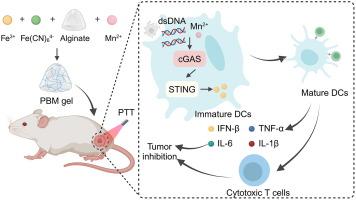即插即用普鲁士蓝锰水凝胶用于肿瘤光免疫体内治疗
IF 13.2
1区 工程技术
Q1 ENGINEERING, CHEMICAL
引用次数: 0
摘要
光热免疫治疗是一种非常有前途的肿瘤联合治疗方法,但开发具有临床转化潜力的光免疫治疗药物仍然是一个相当大的挑战。在此,我们开发了一种即插即用的普鲁士蓝锰凝胶(PBM凝胶)用于体内肿瘤光免疫治疗。只需将Fe3+, Fe(CN)64-,海藻酸钠(ALG)溶液和Mn2+混合,即可在几分钟内快速合成PBM凝胶,无需进一步纯化(收率为100 %),可以立即使用。PBM凝胶具有几个关键优势,包括简单的组成,易于遵循的合成过程,成本效益和大规模生产能力(单批超过1000 g)。此外,PBM凝胶具有出色的近红外II光热加热能力(占光热转换效率的23% %)、免疫激活效果和芬顿样催化活性。在小鼠肿瘤模型中,PBM凝胶在较低的功率密度下通过光热与免疫治疗相结合,有效抑制肿瘤生长,且无明显副作用。鉴于PBM凝胶的所有成分都是fda批准的药物或生物材料,并且考虑到其即插即用的性质,所提出的PBM凝胶为开发强大的肿瘤联合治疗提供了一种新的临床可翻译策略。本文章由计算机程序翻译,如有差异,请以英文原文为准。

Plug-and-play prussian blue-manganese hydrogel for tumor photoimmunotherapy in vivo
Photothermal-immunotherapy is a highly promising approach for tumor combination treatment, but developing photoimmunotherapy agents with the potential for clinical translation continues to present a considerable challenge. Herein, we developed a plug-and play prussian blue-Mn gel (PBM gel) for in vivo tumor photoimmunotherapy. The PBM gel was rapidly synthesized within minutes by simply mixing Fe3+, Fe(CN)64-, sodium alginate (ALG) solution, and Mn2+, without the need for further purification (100 % yield), making it ready for immediate use. The PBM gel offers several key advantages, including a simple composition, an easy-to-follow synthesis process, cost-effectiveness, and large-scale production ability (over 1000 g in a single batch). Furthermore, PBM gel exhibited outstanding near-infrared II photothermal heating capability (23 % of photothermal conversion efficiency), immune activation effects, and Fenton-like catalytic activity. In a mice tumor model, the PBM gel effectively suppressed tumor growth by combining photothermal and immunotherapy at a lower power density without obvious side effects. Given that all components of the PBM gel are FDA-approved drugs or biomaterials, and considering its plug-and-play nature, the proposed PBM gel offers a novel clinically translatable strategy for the development of powerful tumor combination treatments.
求助全文
通过发布文献求助,成功后即可免费获取论文全文。
去求助
来源期刊

Chemical Engineering Journal
工程技术-工程:化工
CiteScore
21.70
自引率
9.30%
发文量
6781
审稿时长
2.4 months
期刊介绍:
The Chemical Engineering Journal is an international research journal that invites contributions of original and novel fundamental research. It aims to provide an international platform for presenting original fundamental research, interpretative reviews, and discussions on new developments in chemical engineering. The journal welcomes papers that describe novel theory and its practical application, as well as those that demonstrate the transfer of techniques from other disciplines. It also welcomes reports on carefully conducted experimental work that is soundly interpreted. The main focus of the journal is on original and rigorous research results that have broad significance. The Catalysis section within the Chemical Engineering Journal focuses specifically on Experimental and Theoretical studies in the fields of heterogeneous catalysis, molecular catalysis, and biocatalysis. These studies have industrial impact on various sectors such as chemicals, energy, materials, foods, healthcare, and environmental protection.
 求助内容:
求助内容: 应助结果提醒方式:
应助结果提醒方式:


